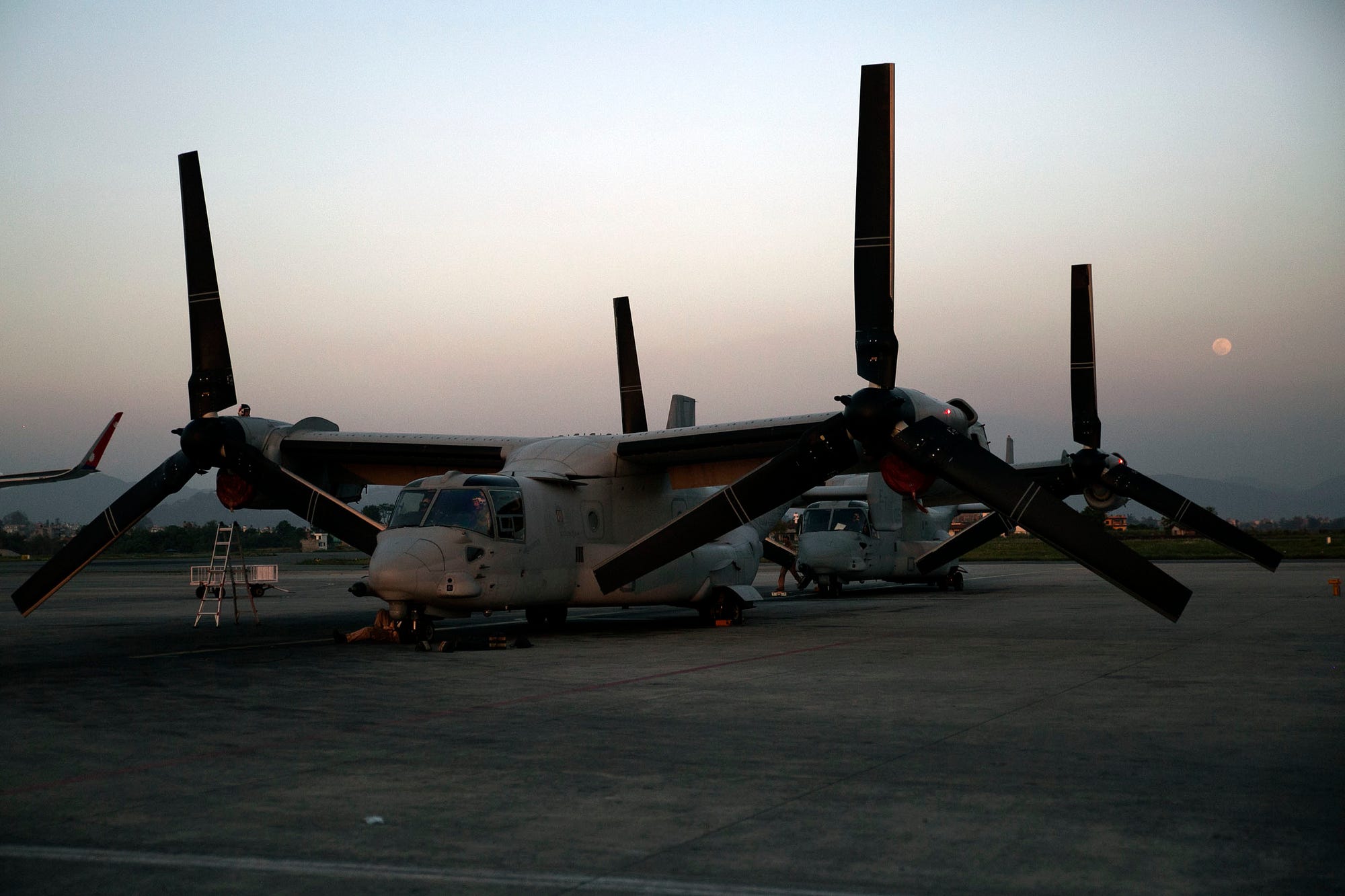JOSEPH TREVITHICK
 Eight months ago, the Pentagon’s top command in the Pacific hosted a training exercise in Nepal, prepping to deal with a major earthquake in the Kathmandu Valley.
Eight months ago, the Pentagon’s top command in the Pacific hosted a training exercise in Nepal, prepping to deal with a major earthquake in the Kathmandu Valley.
On April 25, that scenario came devastatingly, horrifyingly true. A quake between 7.8 and 8.1 magnitude rocked the small Himalayan nation.
Thousands of buildings collapsed. Thousands of people died.
And now, acting out the responses it practiced back in August, the U.S. Marine Corps has sent UH-1Y helicopters and MV-22 Osprey tiltrotors—which fly like regular planes but can land like choppers—to help deliver rescuers and supplies, scout damaged towns and retrieve the injured.
The Ospreys are capable of “delivering aid twice as fast and five times farther than previous helicopters,” which “enhances the operational reach of relief efforts,” according to a Marine Corps press release boasted. The tiltrotors flew in from Japan under their own power.
The U.S. Air Force ferried the shorter range UH-1s to Kathmandu’s Tribhuvan International Airport. The flying branch’s cargo planes had already delivered tons of humanitarian aid and ferried in civilian first-responders.
Eight months ago, Marines and other American personnel were in Nepal alongside troops and civilians from around 20 other countries, all responding to a fake earthquake.
The exercise participants focused on quickly setting up an improvised communications network to help Nepalese authorities and humanitarian organizations distribute information, deliver aid and coordinate emergency services.
The underlying story for the training program—nicknamed Pacific Endeavor 2014—describes the current, real situation almost to the letter.
The mock quake had a registered magnitude of 8.2, knocking out roads, bridges, power lines and sewage systems, official briefings explained. Aftershocks caused even more damage and delayed first responders.
A week after this fictional disaster occurred, emergency personnel had identified nearly 6,000 of the nearly 14,000 dead, according to one of the updates event organizers handed out during the sessions. “Morgues are not accepting bodies due to insufficient space.”
“Sixty percent of buildings in densely built-up areas are destroyed or unsafe,” a mock situation report added. More than a half a million simulated people were homeless.
In the real Nepal, more than 7,000 people have died and more than 14,000 have been injured in the actualearthquake. The disaster has forced more than three million Nepalis from their homes.
In the country’s Gorkha District just west of Kathmandu, the earthquake destroyed nearly 90 percent of all houses. Roads are impassable in many rural areas.
“Hospitals near Kathmandu are reportedly low or have run out of medical supplies,” the Marine Corps’ Joint Task Force 505 noted. “The lack of clean water and flushing toilets is increasing the potential for the spread of water-borne diseases, diarrhea and respiratory diseases.”
Unfortunately, the “needs on the ground are still not 100-percent clear as some of the hardest-hit areas are also the most remote,” the Marine summary added.
The Pacific Endeavor scenario has turned out to be almost disturbingly prescient.
The Pentagon didn’t just just randomly decide on this particular mock disaster storyline. For more than a decade, the international community has worried about what would happen to the mountainous South Asian country after a major seismic event.
In the last hundred years, earthquakes in Nepal have killed more than 27,000 people, Nepali authorities explained as American officers developed the final training plan. Over the past four decades, the same number of people died in more than 15,000 recorded natural disasters — including quakes and floods.
In 2012, the United Nations Development Program ranked Nepal 11th in nations at risk for major quakes, the representatives from Kathmandu pointed out in their briefing slides. “[The] World Bank … classifies Nepal as one of the global ‘hot-spots’ for natural disasters.”
Most notably, the Bihar-Nepal Earthquake destroyed a fifth of all buildings in the Kathmandu Valley and razed a quarter of the structures in the capital in 1934. In 1997, the U.S. Agency for International Development had even funded a study to see just how bad the situation would be if a similar seismic shock hit the country.
Two years later, California-based nonprofit GeoHazards Internationalconcluded that 40,000 people would die and nearly a million would be displaced by a equally massive earthquake. GeoHazards concluded their work by proposing improvements to the building codes for schools and other infrastructure, as well as educating people on what to do in an emergency.
However, Nepal’s civil war and political instability—including Crown Prince Dipendra’s massacre of his parents and other Royal family members in 2001—made it difficult for the country to make these necessary improvements. The volatile situation limited Washington’s involvement, as well.
But in 2012, the commander of the III Marine Expeditionary Force declared outright that Nepal was high on the Corps’ radar in the Pacific. “Priority focus will be placed on a major earthquake in Nepal,” Maj. Gen. Peter Talleri wrote in an annual guidance statement.
In 2013 and 2014, the U.S. Army’s main headquarters for the Pacific region held two separate disaster preparedness drills of their own in Nepal. And along with the Marines, the Air Force participated in the 2014 iteration of Pacific Endeavor.
Now, the Pentagon will get to see whether all of this training has really paid off.
No comments:
Post a Comment